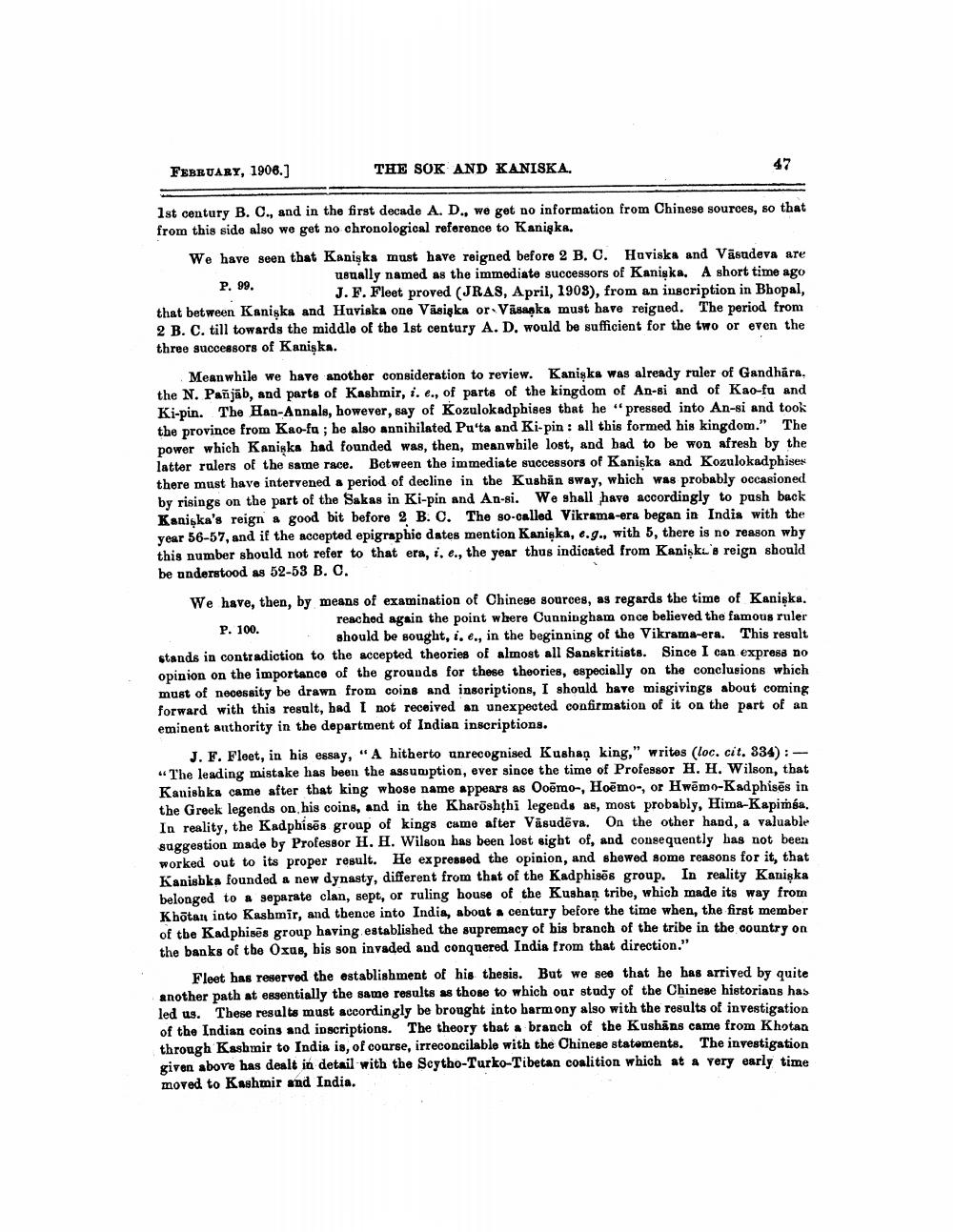________________
FEBRUARY, 1906.)
THE SOK AND KANISKA.
1st century B. C., and in the first decade A. D., we get no information from Chinese sources, so that from this side also we get no chronological reference to Kaniaka. We have seen that Kanigks must have reigned before 2 B. C. Haviska and Väsudeva are
usually named as the immediate successors of Kanigka. A short time ago P. 99.
J. F. Fleet proved (JRAS, April, 1909), from an inscription in Bhopal, that between Kanisks and Huviska one Väsiska or Vasaska must have reigned. The period from 2 B. C. till towards the middle of the 1st century A. D. would be sufficient for the two or even the three successors of Kaniska.
Meanwhile we have another consideration to review. Kaniska was already ruler of Gandhára. the N. Pañjāb, and parts of Kashmir, i. e., of parts of the kingdom of An-si and of Kao-fu and Ki-pin. The Han-Annals, however, say of Kozulokadphises that he "pressed into An-si and took the province from Kao-fa; be also annihilated Pu'ta and Ki-pin : all this formed his kingdom." The power which Kaniska had founded was, then, meanwhile lost, and had to be won afresh by the latter rulers of the same race. Between the immediate successors of Kaniska and Kozulokadphises there must have intervened a period of decline in the Kushän sway, which was probably occasioned by risings on the part of the Sakas in Ki-pin and An-si. We shall have accordingly to push back Kaniska's reign a good bit before 2 B. C. The so-called Vikrama-era began in Indis with the year 56-57, and if the accepted epigraphic dates mention Kaniska, e.g., with 5, there is no reason why this number should not refer to that era, i, e., the year thus indicated from Kaniski's reign should be understood as 52-53 B. C. We have, then, by means of examination of Chinese sources, as regards the time of Kaniska.
reached again the point where Cunningham once believed the famous ruler P. 100.
should be sought, i, e., in the beginning of the Vikrama-era. This result stands in contradiction to the accepted theories of almost all Sanskritists. Since I can express no opinion on the importance of the grounds for these theories, especially on the conclusions which must of necessity be drawn from coins and inscriptions, I should have misgivings about coming forward with this result, bad I not received an unexpected confirmation of it on the part of an eminent anthority in the department of Indian inscriptions.
J. F. Fleet, in his essay, "A hitherto unrecognised Kushaq king," writes (loc. cit. 334): - "The leading mistake has been the assumption, ever since the time of Professor H. H. Wilson, that Kanishka came after that king whose name appears as Ooēmo-, Hoēmo-, or Hwēmo-Kadphisēs in the Greek legends on his coins, and in the Kharosh¢hi legends as, most probably, Hima-Kapimba. In reality, the Kadphísēs group of kings came after Vasudēva. On the other hand, a valuable suggestion made by Professor H. H. Wilson has been lost sight of, and consequently has not been worked out to its proper result. He expressed the opinion, and shewed some reasons for it, that Kanisbka founded a new dynasty, different from that of the Kadphisēs group. In reality Kaniska belonged to a separate clan, sept, or ruling house of the Kushan tribe, which made its way from Khotan into Kashmir, and thence into India, aboat a century before the time when, the first member of tbe Kadphisēs group having established the supremacy of his branch of the tribe in the country on the banks of the Oxus, bis son invaded and conquered India from that direction."
Fleet has reserved the establishment of his thesis. But we see that he has arrived by quite another path at essentially the same results as those to which our study of the Chinese historians has led us. These results must accordingly be brought into barmony also with the results of investigation of the Indian coins and inscriptions. The theory that a branch of the Kushåns came from Khotan through Kashmir to India is, of coarse, irreconcilable with the Chinese statements. The investigation given above has dealt in detail with the Scytho-Turko-Tibetan coalition which at a very early time moved to Kashmir and India.




